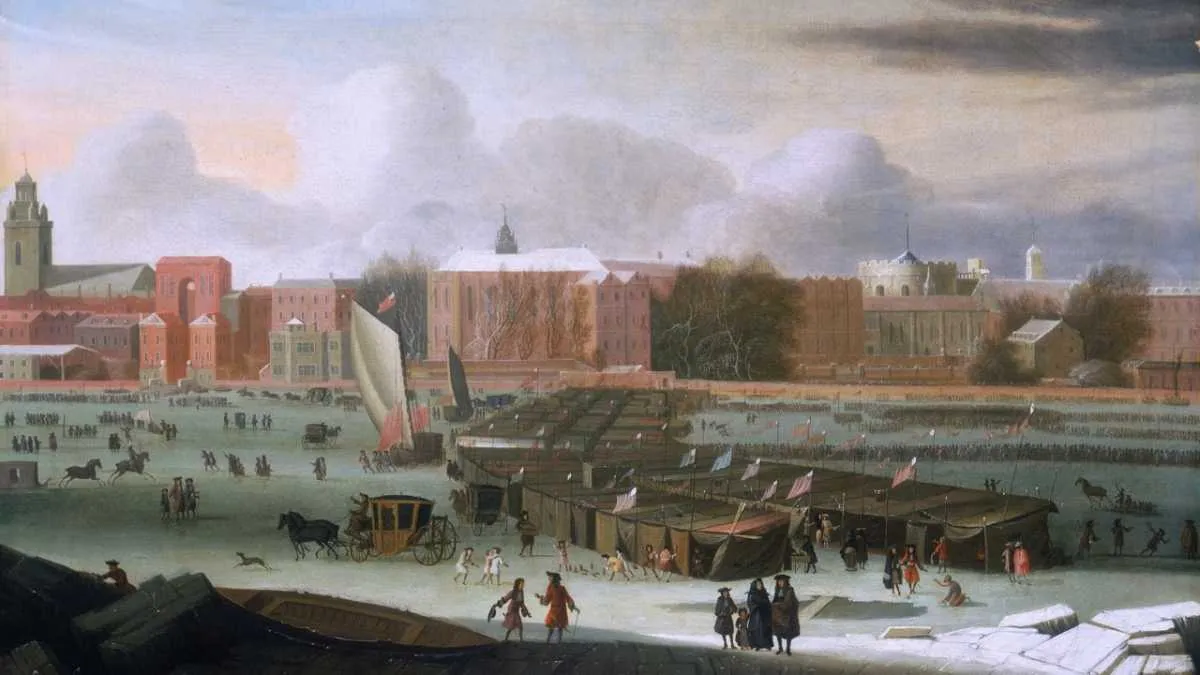On 2 January 1565, the little Dutch town of Delfshaven, close to Rotterdam, became the scene of a surprising spectacle. An iceberg crashed into the coast and was soon swarmed by curious locals exploring the towering mass, marvelling at its bulk and measuring its size. The painter Cornelis Jacobsz van Culemborch documented the strange event. On his panel, a little group of onlookers can be seen dancing on the ice in front of the glacial visitor. The cold of the scene is almost palpable.
The iceberg off Rotterdam was a harbinger of change. Winters were becoming longer and more bitter across the globe, summers frequently more brief and less sunny. For the inhabitants of temperate zones such as Europe this creeping but unstoppable transformation heralded not only freezing temperatures, but also hunger and hardship, epidemics and social unrest. The Little Ice Age had begun.
We do not know exactly what caused temperatures to drop by roughly two degrees Celsius, beginning in the late Middle Ages and reaching a frosty climax during the late sixteenth and seventeenth centuries. Recent research suggests that the European conquest of South America may have played a part, as European viruses slew large portions of the indigenous population, allowing forests to reclaim land previously used for farming. More and larger trees absorbed more CO2 from the atmosphere, so the reasoning goes, causing a cold snap. This, however, would at best explain a fraction of this dramatic climatic event, which also began almost a century before Columbus set sail.
While the exact causality of the Little Ice Age are still the subject of research and debate, its effects are very well documented. From the 1570s onwards, bitter winters saw harbours in the Mediterranean freeze over until late spring; entire armies could move across the smooth surface of the frozen Danube, while Londoners held raucous fairs on the Thames, complete with streets of booths selling everything from printed mementoes to warming and intoxicating beverages. In France, soldiers had their wine rations sawn from solid blocks of ice, while in Russia cavalrymen were said to fall off their horses, frozen solid.
Harsh winters, however, were only part of the problem confronting European societies. Cool and rain-sodden summers did not allow harvests to ripen and frequently the distraught countryfolk had to watch the corn rotting in the fields before it could be brought in. Famines tripled in frequency, as did epidemics, which had a far more lethal effect on populations weakened by hunger. The order of the world ordained by God had become unhinged, it seemed.

“Europe where the sun dares scarce appear / For freezing meteors and congealed cold,” sighed Christopher Marlow in 1578. Shakespeare’s Richard III may have played on similar associations when he was musing about “the winter of our discontent”, while his tragedy Coriolanus, set in ancient Rome, makes an even more direct allusion to current events: it starts with a bread riot, a frequent occurrence as urban population suffered from the rapid inflation of grain prices due to failing harvests. Shakespeare worked on the play during the bitter winter of 1608, as bread riots broke out across London. In Flanders, meanwhile, winter was discovered as a subject of landscape painting.
What changes in a society when the climate changes? The Little Ice Age offers a historical case study. European populations still mainly relied on subsistence agriculture. Their societies were conceived as a social pyramid, with the poor at the bottom and land-rich nobles on top. Now this order was beginning to fissure dramatically. As local agriculture and traditional farming were failing with alarming frequency, societies began to react.
The first reaction was the logical consequence of medieval thinking. The cold was seen as divine punishment. Bad harvests were followed by religious processions and prayers of penitence, by fiery sermons - and by the burning of witches accused of destroying the crops. Within a generation, however, it began to transpire that fervent prayers and persecutions did nothing to address the problem of cold and starvation.
Slowly and by trial and error, other solutions emerged. Botanists began to research more effective farming techniques and new crops such as potatoes, land ownership was restructured by abolishing the commons on which the rural poor had been allowed to graze their cattle in favour of commercial agriculture producing for markets.
This meant not only that countless expelled and landless poor had to move into the cities, but also that the trade in grain made cities like Amsterdam wealthy and powerful, creating a new economic model along the way: economic growth based on exploitation, brutally effective method which would become the secret of Europe’s global power grab over the next three centuries.
When temperatures and harvests recovered to pre-1570 levels during the eighteenth century, Europe’s social, political and economic landscape had changed radically. Feudal, late medieval societies were well on their way into a modernity dominated by more dynamic (and more destructive) economies, the triumph of the scientific method, early industrialisation, the rise of the urban middle classes, and, ultimately, the Enlightenment, which argued forcefully that the old order must make way to a new, egalitarian way of living based not on faith, but reason.
The Little Ice Age, of course, did not directly cause this sweeping transformation, but it did create conditions which made innovation and adaptation necessary, and rewarded those willing to leave their old world behind them and to embrace new ways of farming, trading, and conducting politics. A new way of living and of understanding the world emerged throughout this process — our own world.
Nature’s Mutiny: How the Little Ice Age Transformed the West and Shaped the Presentby Philipp Blom is available now (£25, Picador)
Follow Science Focus onTwitter,Facebook, Instagramand Flipboard